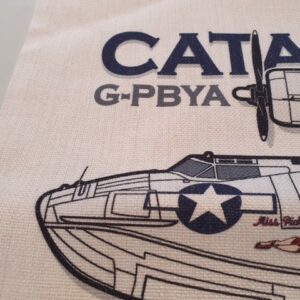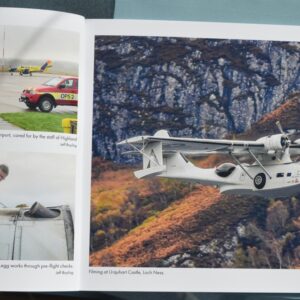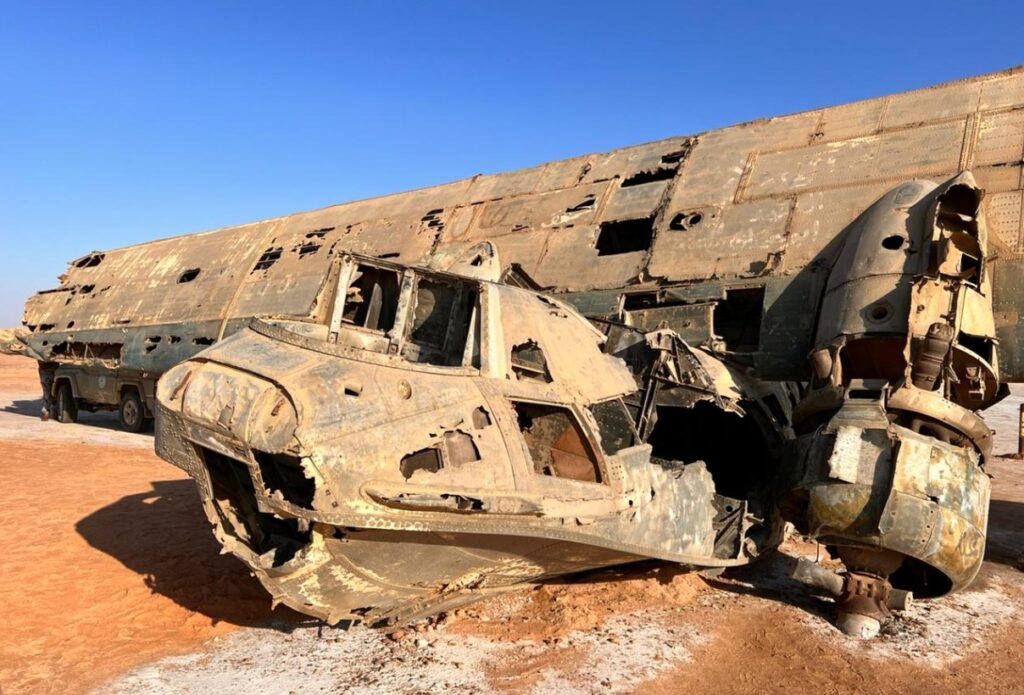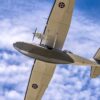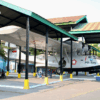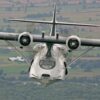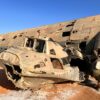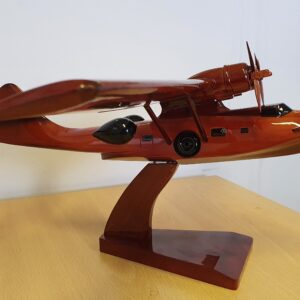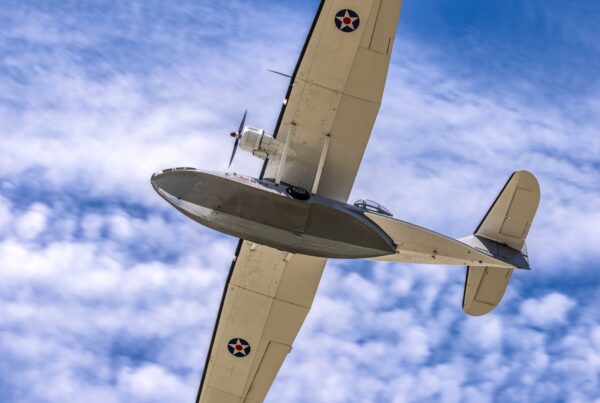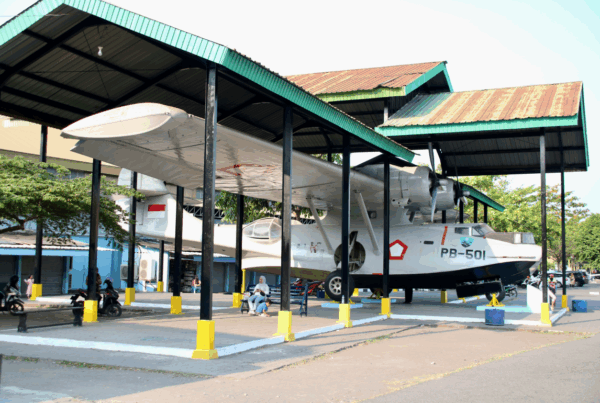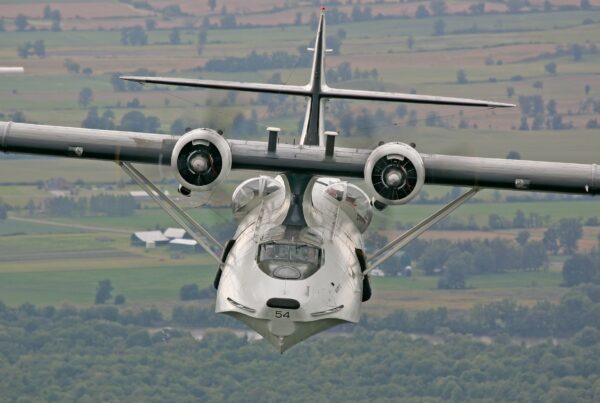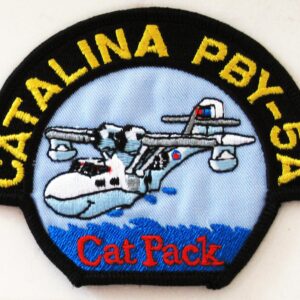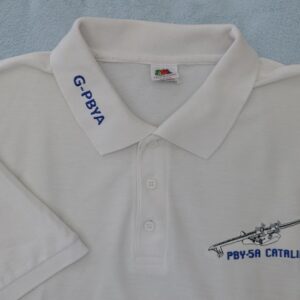There never seems to be any shortage of news about Catalinas from around the world so here is what has been going on since the last edition of our printed magazine (The Catalina News magazine is sent to subscribing members of The Catalina Society – see ‘memberships’ tab on this website).
There has been concern for some time about the PBY-6A Catalina L-866 that is parked out in the open at the Royal Air Force Museum Midlands at RAF Cosford in Shropshire, UK. I have mentioned it several times over the years since it was removed from the hangar it had been displayed in and ‘temporarily’ placed outside. More recently it appeared on the RAF’s ‘Loans List’ as available for any museum that could care for it in a good home. There do not appear to have been any takers and since my last report on this ex-Royal Danish Air Force machine, the fabric has been removed from all the wing surfaces although I am told that the empennage fabric remains in place. Whether this is to prevent further deterioration or for repairs to be carried out I do not know. It is a great shame that she continues to be left in the open.
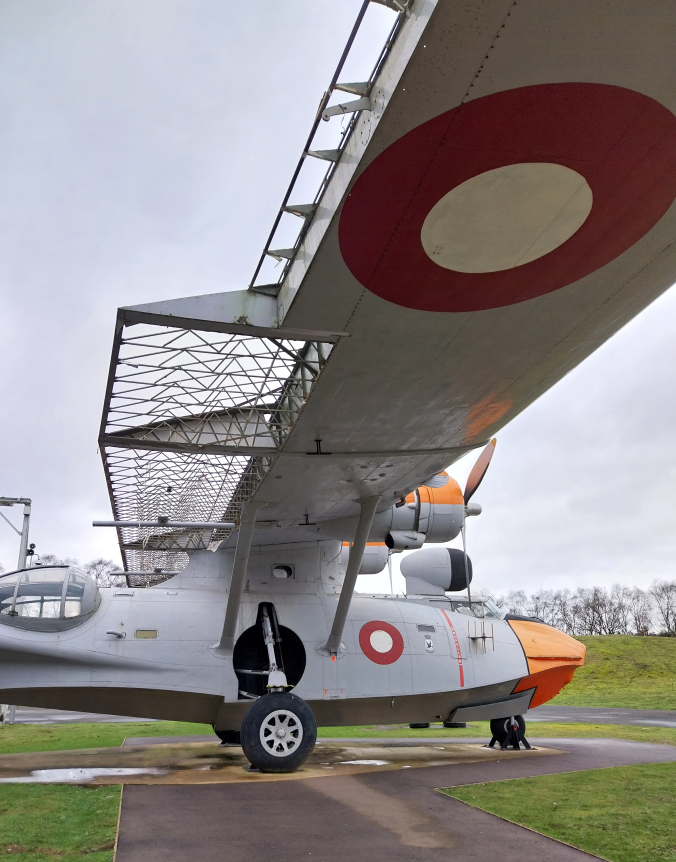
Rob Evans’ photo of the PBY-6A L-866 out in the open at Cosford on February 4th this year shows the bare trailing edges after fabric removal
Another Catalina that has featured in this column before is the one-time USAAF OA-10A Catalina CC-CDT in Chile. In the last issue, I mentioned that it had supposedly been sold to an American owner. The latest news I have is that it is still at Arturo Merino Benitez Airport, Santiago, Chile where it has been parked un-flown for many years, albeit with regular engine runs. My contact in Chile, Álvaro Romero, tells me that as at the beginning of this year, it was engineless and that a large part of the trailing edge had been removed due to corrosion and will require re-covering with new fabric. Perhaps this work is being carried out prior to export to the USA? The owner since October 2021 has been Manutara Sociedad por Acciones (SpA or joint stock company) and this is still quoted on the Chilean Aircraft Register.
In the Netherlands, the former Dutch MLD PBY-5A Catalina 16-212 has been moved again. In August 2020 it was transported to the premises of the Nederlands Transport Museum, Nieuw-Vennep for restoration after many years of external display and storage in dismantled state. However, in a surprise move, it was subsequently announced that the Nieuw-Vennep premises were to be closed and so 16-212 had to be moved again with restoration only partially completed. Over the period September 20th to 22nd last year, the entire airframe was roaded back to the Nationaal Militair Museum (NMM) at the old airbase at Soesterberg from whence it had come back in 2020! It is now ensconced in Hangar 8 on the base, one of the oldest hangars there. Prudent Staal, a member of the Stichting Neptune Association restoration team, tells me that the move had to be undertaken on a very tight timescale, but it was achieved on schedule with help from the transport company Nemico BV and the Stichting Mobiele Artilerie (Mobile Artillery Foundation). With the transfer complete, the team still needs to rebuild the rear-hull blisters but, apart from that, restoration is almost complete so hopefully it will not be too long before reassembly can take place.
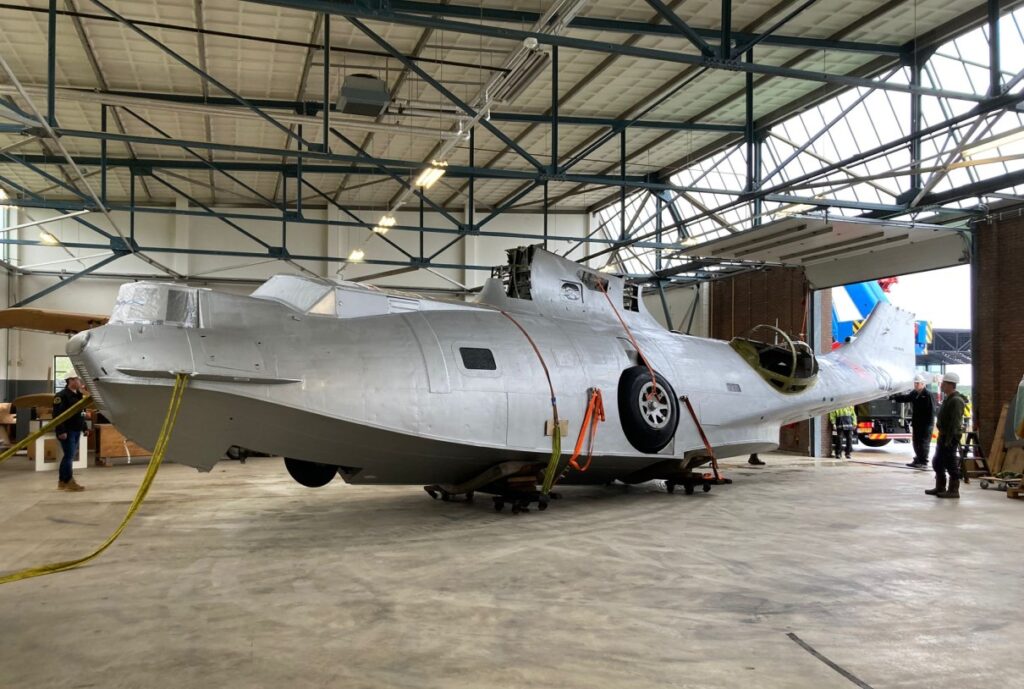
PBY-5A Catalina 16-212 arrives at the Nationaal Militair Museum (NMM) at the old airbase at Soesterberg after its move from Nieuw-Vennep last September
Prudent Staal
Moving on to the USA there is plenty of news. First, the long-term restoration project involving the last Catalina to be built, PBY-6A N9825Z, has been sold. Originally taken on by Frederick Peterson in 1999 after acquisition from the waterbombing company SLAFCO, he started a long-term restoration project at Moses Lake, Washington State with the intention of making it the most ‘stock’ example in the world, amassing a large cache of spare parts in the process. Sadly, he passed away a few years back and ownership officially passed to his widow Susan in March 2021. She was keen to sell it to a suitable buyer and, on January 28th this year it was registered to Vintage Aircraft Restorations LLC of Spokane, WA. The Catalina is still parked at Moses Lake at the time of writing and I’ll bring readers more information when it is made public – STOP PRESS: it has now been moved – more news in our next edition.
Another former SLAFCO waterbomber is PBY-5A ‘Super Catalina’ N9505C which has been in open storage in increasingly scruffy condition at Ephrata, WA for many years. Plans to use it for flying in the Bahamas by its owners, Flying Fox Air Service LLC, never materialised. In Issue 100, I reported that this Wright Cyclone-powered Catalina had been impounded by the Port of Ephrata because of unpaid dues and that it was possible it would be put up for auction if the owners did not settle. This duly happened and the successful bidder at a reported $33,000 was the Yanks Air Museum of Chino, California. The museum is now faced with dismantling and moving the aircraft to California as soon as possible. Once there it will join yet another ex-SLAFCO aircraft, ‘Super Catalina” N2763A, that the museum acquired many years back. It has been in dismantled storage at Chino ever since so perhaps, with the acquisition of N9505C, restoration will be given impetus. N9505C was made famous back in 1988/9 when it was used in the making of the film Always, the opening sequence of which is very well-known – check it out on the internet if you are not familiar with it!
Back in August 2022, former RCAF Canso A N413PB belonging to Hans Lauridsen as part of his collection of old aircraft at Buckeye Municipal Airport, Arizona was overturned in high winds and very badly damaged – see Issue 98. News from Buckeye is not good. Back in August last year, Niklas Becht from Germany shared a YouTube video with me that showed the shocking state of the Catalina sometime after the incident. See www.youtube.com/watch?v=ARP-LN-LUyU Since then, things have not got better. Robert Feeley visited Buckeye in mid-March and was able to access the private property on which the aircraft collection is kept. He reports that the wing and rear hull/tail section aft of the stern post at Bulkhead 7 have been scrapped and what is left ‘isn’t pretty’! The starboard side of the hull and cockpit area appear to have sustained post-accident damage, possibly inflicted by ‘salvors’ and the cockpit roof has gone with the windows all smashed. The forward section of the hull was under cover in an open hangar next to a pile of bent props, damaged floats and engine cowlings. Robert was told that someone was coming to collect the remaining parts, possibly from Pima, AZ but not confirmed. A sad and unnecessary end to this aircraft which looks as if it will have to be deleted from my ‘Survivors’ listing.
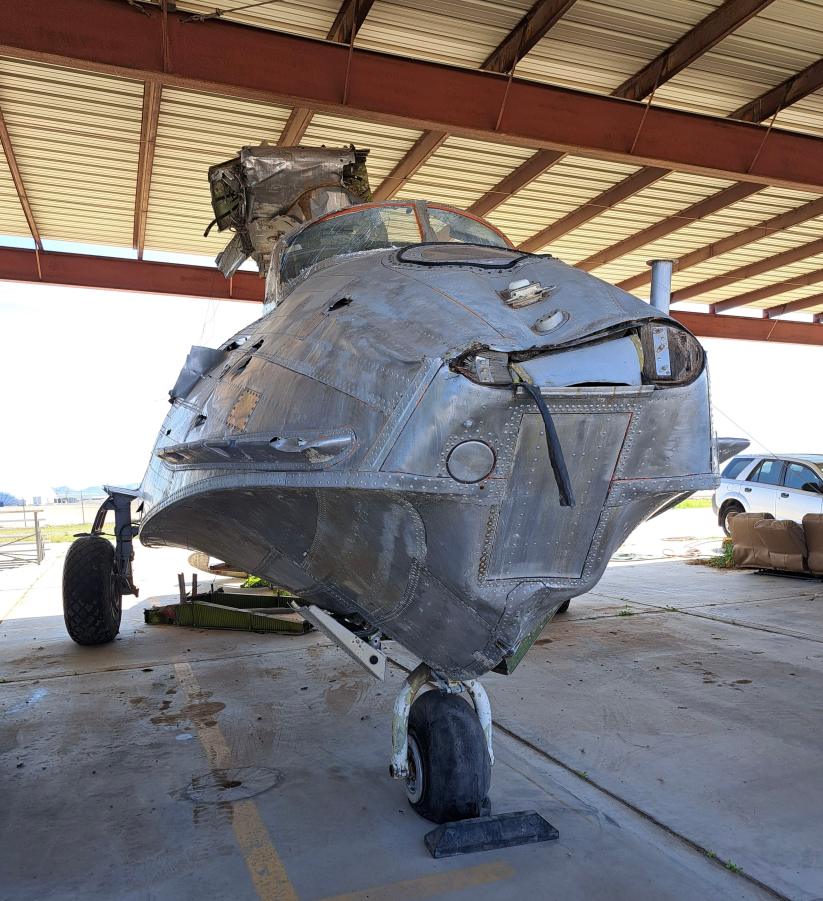
Cockpit and bow section of the wrecked N413PB at Buckeye Municipal Airport, Arizona in mid-March this year
Robert Feeley
On a recent visit to the McChord Air Museum Foundation at McChord Air Force Base, Washington State, Paul Ashenden saw and photographed the PBY-5A last registered N4760C. Ordered for the US Navy but delivered as new to the USAAF as an OA-10 Catalina, she flew as an airliner in Alaska from 1949, later being re-engined with Wright R-2600 Cyclones. She subsequently became an aerial geophysical survey aircraft and visited the UK several times in the 1970s and early-1980s. Damaged beyond repair in a forced landing in a field at Lynn near Granton, Wisconsin in March 1983 after port engine failure, she eventually found her way to McChord where over a period of several years he was converted back to a PBY-5A/OA-10 configuration and painted as OA-10A 44-34033. Recently re-painted, Paul’s photos suggest she is in fine condition externally at least.
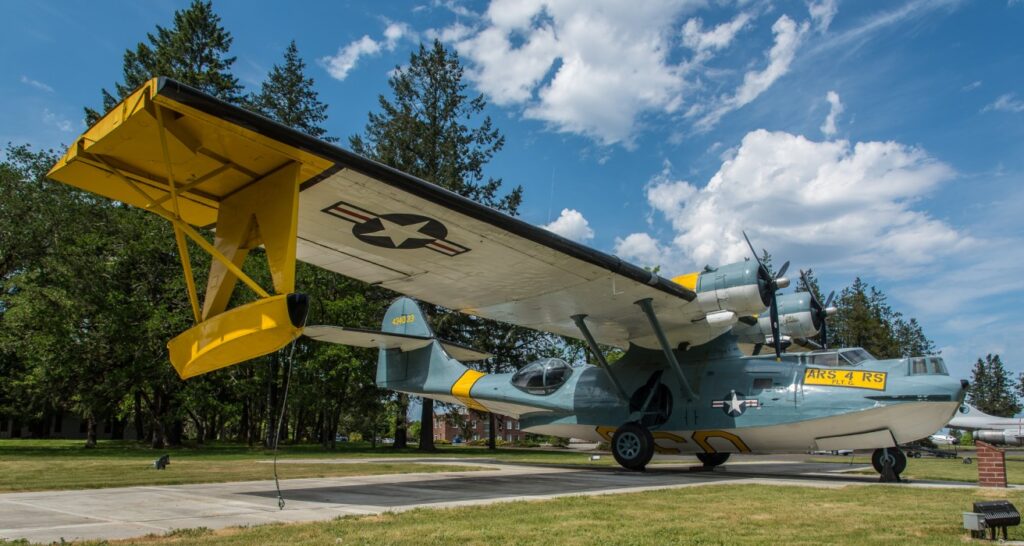
The former N4760C on static display at the McChord Air Museum Foundation at McChord Air Force Base, Washington State Paul Ashenden
Three PBY-6A Catalinas, N9562C, N9563C and N9584C have recently been formally deleted from the US Civil Aircraft Register (USCAR), two of them ‘deceased’ many years ago. N9563C and N9584C were both acquired as surplus from the US Navy storage facility at Litchfield Park, AZ by Aircraft Instrument Corporation of Miami in the mid- to late-1950s after being struck off charge on August 22nd, 1956. The owner acquired a large number of surplus PBY-6As around that time and it seems likely that they were nearly all used for spare parts as, although they appeared on the USCAR, they were barely heard of again. Both were de-registered on February 1st, 1971 due to non-submission of paperwork by the owner and, in a cleaning-up exercise, the Federal Aviation Administration finally cancelled the registrations, N9563C on 16th August 2023 and N9584C on 16th December, 2023. N9562C was also acquired by Aircraft Instrument Corporation but it did not share the same fate as most of their Catalinas and, in a long commercial career, it was operated in Chile from 1957 until retirement around 2000 as both a passenger aircraft and, later, a waterbomber, latterly in Spain and Portugal. It is now current with Historic Aircraft Restoration Society (HARS) at Shellharbour Airport, Sydney, NSW where it has been airworthy since 2003 as VH-PBZ although it is currently undergoing a major overhaul before flying again. It was finally cancelled from the USCAR on September 2nd last year.
Talking of Australia, here is an update on the PBY-5A, formerly N7238Z, Our Girl. The restoration project commenced back in early-2014 after the Catalina was acquired in Puerto Rico in poor condition and shipped to Australia. Various parts of the airframe were worked on at different locations in the Lake Macquarie area until the project was moved to Beresfield in NSW in December 1922. On November 30th, last year the following press release was announced: ‘A historic aircraft is being restored to its original wartime configuration after it was handed over to the Royal Australian Air Force. The Rathmines Catalina Association (RCA) formally passed the former US Navy PBY-5A Catalina Our Girl to History and Heritage – Air Force (HH-AF) during the aircraft’s 80th birthday commemoration activities in Beresfield, NSW on November 17th, 2023. Director-General HH-AF, Air Commodore Robert Lawson, accepted Our Girl into the Air Force heritage collection on behalf of HH-AF and Air Force. Built in 1943, Our Girl saw service with the US Navy during World War 2. RCA volunteers are restoring the aircraft to her original wartime configuration in support of HH-AF, while HH-AF’s Office of Air Force History is researching the livery in which to paint the aircraft to appropriately represent RAAF Catalina operations from Rathmines, NSW. Our Girl’s restoration and future display are important on several fronts. Our volunteers are maintaining and using skills learned over many years; the work days provide an avenue for fellowship and an aid to men’s health. “Our members, many with family ties to the Catalina squadrons, and the public at large, are experiencing the rebuilding of an aircraft that was a part of the defence of Australia,” said RCA President Boll Anderson. Project Officer Wing Commander Richard Dyson said it was a major restoration. “The wings of the aircraft were discovered to have significant corrosion of their internal framework and lower surfaces, as water had soaked in over many years while Our Girl was grounded in Puerto Rico. Similarly, significant ingress of water and debris into the fuselage has had a similar effect on the hull integrity”, he said. The RCA have made significant inroads into the restoration and repair of these issues. The nose of the aircraft is being converted back to its 1943 configuration with the installation of a bow gun turret well progressed. This turret was beautifully restored by the Directorate of Air Force Heritage’s Restoration Support Section at RAAF Amberley, Queensland. Wing Commander Dyson said that there was still significant work to be done on the internals of the aircraft, with a need to construct a navigator station which was removed post-war. The RCA continues to receive significant sponsorship support from a number of local industries, including the provision of equipment, paint and other materials.’ It is worth pointing out that much of the sheet metal work restoration, particularly in the bow area, carried out before the move to Beresfield was carried out by volunteer Steve Wenban who passed away last Autumn.
Finally, an update on PBY-5A N5593V which has lain derelict in the Saudi desert since March 1960. Abandoned at Ras Ash Shaykh Humayd, Gulf of Aquaba after being badly damaged on the water by gun fire from Arab gunmen, the Catalina gradually deteriorated until fairly recently when its decline accelerated. Iain Macbeth visited the site, now being developed with the new name NEOM, last October and reports that the wreckage is located on a flat beach of hard packed sand in a small inlet protected from the open sea. The authorities have built a sand berm around the area to keep out vehicles and when I was there a civil defence land cruiser was patrolling the site so the wreck is sort of protected. The NEOM authorities have even built a toilet block for visitors nearby and are building a museum about 80km away so perhaps some of the Catalina parts will find their way there, although by the time it is built it may be too late as N5593V is now in very poor condition indeed.






